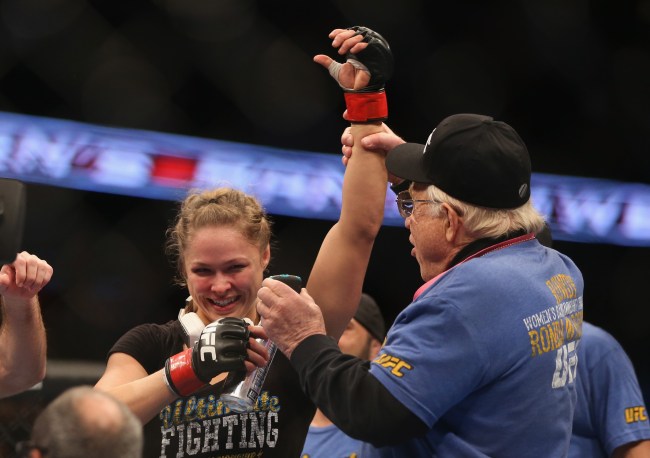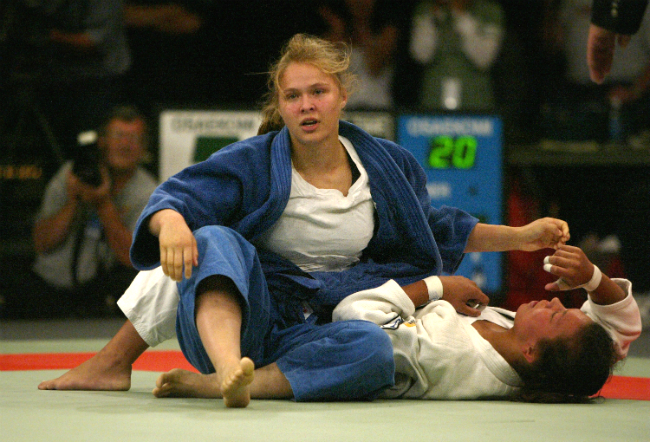
Ronda Rousey began fighting from the start. She was deprived of oxygen during her birth, and doctors feared she would have brain damage. Although she would have trouble speaking — uttering her first sentence at 6 years old — the current Women’s Bantamweight Champion fought past the initial obstacle. At UFC 190, Rousey plans on proving, once again, that she was born and bred to be a champion. Her mother, AnnMaria De Mars, followed a similar trajectory, starting training in judo at the age of 16. In 1984, De Mars won the World Judo Championships in the -56 kg class.
Growing up, Rousey’s mother would routinely challenge her with grappling contests at home. As the young girl grew into a young woman, De Mars placed her daughter with world class coaches to cultivate her judo abilities, with one of her early trainers being Gene LeBell, a legendary judo practitioner and former pro wrestler who won several judo championships in the ’50s. Rousey’s early judo career also saw her employ the talents of Gokor Chivichyan, Karo Parisyan, and Manny Gamburyan as training partners. “Rowdy” started off in the junior national championship circuit, winning twice before moving onto the senior circuit to claim six championships. From there, she won gold at the Pan-Ams, as well as the junior world championships. At just 17 years old, Rousey qualified for the 2004 Athens Olympic team; she was the youngest judo participant that year, and placed ninth in the games.

Ronda Rousey competes in the 2004 Olympics at age 17.
In 2007, Rousey won a silver medal at the world championships, and she would again become an Olympic contender at the 2008 games in Beijing. She would leave the games with a bronze medal, losing only to Edith Bosch of the Netherlands.
In 2010, Rousey began her foray into the world of mixed martial arts. Her debut amateur fight, against Hayden Munoz, went the way of many of her fights… a first-round armbar.
That same year, Rousey entered the Tuff-N-Uff amateur tournament, winning her first fight via armbar in just 57 seconds. Her semifinal match in January of 2011 went even quicker, Rousey winning via armbar against Taylor Stratford in just 24 seconds. Her amateur career was so dominant that instead of competing in the finals of the tournament, Rousey decided to turn pro. In March of 2011, “Rowdy” competed in her first professional mixed marital arts bout at King of the Cage: Turning Point. Like her previous bouts, the soon-to-be UFC star used her grappling acumen to take the fight to the ground, finishing via armbar 25 seconds into the fight.
Quick finishes for Rousey also meant quick turnarounds. She fought again in June against Charmaine Tweet, leaving the cage following another first-round finish via submission. The logical next step was competing on a grander stage, and Rousey found that in the form of Strikeforce. At Strikeforce 18 in August of 2011, Rousey fought Sarah D’Alelio, but the bout wasn’t without controversy. Referee Steve Mazzagatti may have stopped the bout early after Rousey told him that D’Alelio had verbally tapped out. Rousey would have likely gotten the submission had the bout continued, but it was a sour start to her national TV debut.
With women’s MMA exploding in popularity, Rousey continued her ascension up the professional fighting ranks. UFC was already the premier organization for MMA, but Dana White had gone on record to say that women would likely never fight in UFC. Rousey, though, took the comments in stride and prepared for her toughest test to date… the Strikeforce World Bantamweight Championship.
On March 3, 2012, just one year into her professional MMA career, Rousey challenged then champion Miesha Tate. The challenger withstood an early flurry from the champion, before scoring a trip and gaining side control. Like her previous fights, Rousey immediately went for the armbar, but Tate somehow escaped. The two scrambled, and Tate was able to get Rousey’s back, but not for long, as the challenger used a backdoor escape. Back on their feet, Rousey was able to score a hip toss and gain a mounted position. From there, Rousey worked in her signature armbar submission and contorted Tate’s arm until her elbow dislocated. The referee stepped in, and Rousey was declared the Women’s Bantamweight Champion in another first-round victory.
Rousey defended her title in Strikeforce just once, against Sarah Kaufman, that same year and ended the fight in similar fashion with a first-round armbar. Other than Cristiane “Cyborg” Santos, few women had gained as much buzz or had been as decisive in every fight as Ronda Rousey. UFC president Dana White succumbed to Rousey’s popularity and skills, and walked back his earlier stance on women’s MMA. In November of 2012, White confirmed that he had signed Rousey as the first female UFC fighter, crowing her the UFC Women’s Bantamweight Champion.
“She’s a real fighter, and she’s very talented,” White said on Jim Rome’s radio show. “She has the credentials, the pedigree; I mean everything. I think she has that ‘it’ factor. I think she’s going to be a big superstar. This girl is nasty.”
“Rowdy” Ronda Rousey has since defended her UFC strap a total of five times, all of the fights, except for one, ending in the first round. At UFC 190, the champ looks to make it six in a row with a title defense against Brazil’s Bethe Correia. Although Rousey claims it’s her most personal test to date, history indicates that it may just be another day at the office for one of the most dominant fighters in the history of mixed martial arts.






